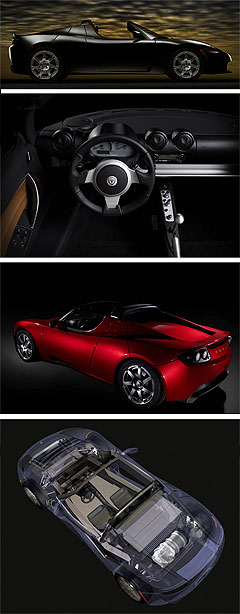Future models - Tesla - RoadsterElectric zealSilent running: Battery-powered Tesla sports car races to 97km/h in less than four seconds. Brilliant Lotus-based electric roadster hits US roads soon3 Oct 2007 By TERRY MARTIN JUST as the mention of Serbian inventor and engineer Nikola Tesla fails to light up the imagination like his archrival Thomas Edison, the American car manufacturer that bears his name does not hold court like the world’s biggest names in the auto business. But that could change. The Californian-based Tesla Motors last week announced a revised production schedule and some quite astonishing performance figures for the electric vehicle it has crafted from the Lotus Elise. Remodelling and re-engineering a proven performance car like the lightweight Elise makes sense. Quite apart from being fabulous to look at, the Tesla Roadster – which was styled by Lotus designer Barney Hatt – strikes an instant chord with car enthusiasts and provides a sound basis for strong and invigorating performance, sans internal combustion engine. It is quite a bit heavier than the standard (circa 800kg) Elise, but the 1220kg Tesla Roadster is faster, ultra-economical and, of course, emissions-free. According to Tesla Motors, in its final phase of testing before entering production (at the Lotus plant in Hethel, England) the electric Roadster recorded consistent 0-60mph (97km/h) acceleration times of less than four seconds – around two seconds quicker than the Elise, and which slots it into the supercar league. Top speed is an electronically limited 125mph (201km/h). Not least of all, the two-seater sports-EV also ran for an astonishing 245 miles (394km) on a single charge when tested according to the US EPA combined cycle. On the highway cycle it managed 235 miles (378km) and on the combined cycle it recorded an incredible 255 miles (410km) – a range that betters all previous production electric vehicles.  Looking for a mileage equivalent? The figure Tesla uses, which takes into account the cost of the electricity it uses, is 135mpg – just 2L/100km. Looking for a mileage equivalent? The figure Tesla uses, which takes into account the cost of the electricity it uses, is 135mpg – just 2L/100km.Developed and manufactured in Taiwan, the electric motor is connected to a battery box – or “energy storage system” (ESS) – which holds 6831 consumer-grade lithium-ion cells. A full recharge from a standard power socket is said to be as short as 3.5 hours. Recharging can take place from home (where an electrician is needed to install a basic charging system), while a mobile charging kit that allows recharging from any electrical outlet will be available as an option. The motor is a three-phase four-pole AC unit able to generate a maximum 185kW and 271Nm. Peak power is achieved at 8000rpm. Peak torque begins at 0rpm and remains at this level to 6000rpm before it tapers off “but remains powerful” (according to Tesla) to the 13,000rpm redline. Power is fed to the rear wheels via a two-speed electric-actuated manual shift transmission, which works like an automatic (there is no clutch). Just the two gears are deemed necessary given the high torque over such a wide rev range. There is no reverse gear the motor runs backwards for reversing. The other main powertrain component is the power electronics module (PEM). This is the network “hub” which works in concert with the gearbox to provide a driving experience not unfamiliar to conventional cars. The PEM also controls motor torque, charging and regenerative braking, and monitors things such as voltage, motor rotation speeds and motor temperatures. Basic chassis specifications mimic the Elise, with unequal-length wishbones front and rear, 16-inch wheels (on 175/55-section rubber) up front and 17-inch wheels (on 225/55s) at the rear. Ditto for braking hardware, which includes AP Racing twin-piston fixed aluminium front callipers (clamping on to 300mm diameter cross-drilled discs), and Brembo single-piston sliding rear callipers (with 310mm rotors). In a letter to customers, all of whom have committed to spend $US98,000 ($A111,500) to purchase the vehicle, Tesla Motors chief executive Michael Marks said last week that a limited number of production cars would be produced in the fourth quarter, but the first customer deliveries would follow in the first quarter of 2008 – about six months longer than the original plan. Another 600 are scheduled in the 2008 model year. There are other Tesla electric vehicles in the works including a sedan, however at this stage there are no plans to produce the Roadster or future models outside North America. That makes it no less significant. Great looks, incredible performance, zero emissions and a total investment of just $US60 million – this is an automotive future the entire world should look forward to. |
Click to shareTesla modelsResearch Tesla Motor industry news |














Facebook Twitter Instagram